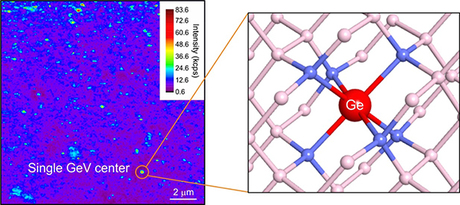Diamond defects produce bright fluorescence

Japanese researchers have discovered that germanium defects in a diamond crystal lattice act as a reliable source for single photons, providing a promising new route to building components for quantum cryptography and biomarkers. Their work has been published in the journal Scientific Reports.
Pure diamonds are naturally colourless, but gaps in the crystal structure or impurities of other elements can create colours and even emit fluorescence — photons of fixed-wavelength light — when illuminated by higher energy light. Researchers have recently shown that fluorescent lattice defects could be useful as single-photon sources for quantum cryptography and as bright luminescent markers in living cells; however, such defects are often unreliable or difficult to fabricate.
Now, research led by the Tokyo Institute of Technology has demonstrated a new type of diamond crystal defect that fluoresces to produce single photons in a narrow, high-energy wavelength band. The defects, which have been named germanium-vacancy (GeV) centres, are said to be relatively easy to fabricate in a reliable, reproducible way.
The researchers were inspired by recent work that demonstrated fluorescence from nitrogen-vacancy (NV) and silicon-vacancy (SiV) defects in diamond. They began with an ion implantation method, which involved firing germanium atoms at high speed into pure diamond surfaces. They then heated the samples at 800°C to induce diffusion of vacancies — gaps in the diamond crystal lattice where a carbon atom is missing.
By using Raman spectroscopy and confocal microscopy, the researchers observed fluorescent light emerging from the samples at a wavelength of around 602 nm, representing a higher energy fluorescence than SiV centres. The team used theoretical calculations to deduce that this fluorescence resulted from combined defects, each comprising a germanium atom next to a lattice vacancy.
Furthermore, the researchers were also able to create the films through the less destructive method of microwave plasma chemical vapour deposition (MPCVD). The defects in the sample prepared using MPCVD gave off more consistent fluorescence, with a narrower and more stable peak. Moreover, MPCVD provides closer control over the fabrication process and is less likely to produce unwanted damage to the samples than ion implantation.
Following further refinement of the fabrication process, the researchers believe their work has opened up a new avenue for sources of single photons, which are essential for quantum cryptography. They are also hopeful that they could incorporate GeV centres in nanodiamonds for use as biological markers.
MRI scanner to advance medical breakthroughs at Monash
Siemens Healthineers' MAGNETOM Cima.X 3T is claimed to be Victoria's most advanced,...
Virtual pathology streamlines rapid onsite evaluation
Technology from Grundium, a specialist in digital imaging for pathology, has been shown to match...
Cannabis detected in breath from edibles
Researchers say they have made the first measurement of THC in breath from edible cannabis, in a...





